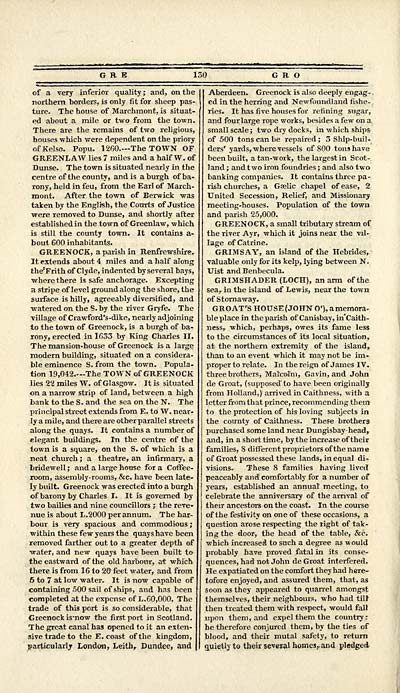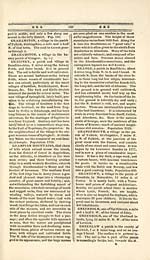Gazetteer of Scotland
(132) Page 130
Download files
Complete book:
Individual page:
Thumbnail gallery: Grid view | List view

G R B 1
of a very inferior quality ; and, on the
northern borders, is only fit for sheep pas-
ture. The house of Marchmont, is situat-
ed about a mile or two from the town.
There are the remains of two religious,
houses which were dependent on the priory
of Kelso. Popu. 1 260.— The TOWN OF
GREENLAW lies 7 miles and a half W. of
Dunse. The town is situated nearly in the
centre of the county, and is a burgh of ba-
rony, held in feu, from the Earl of March-
mont. After the town of Berwick was
taken by the English, the Courts of Justice
were removed to Dunse, and shortly after
established in the town of Greenlaw, which
is still the county town. It contains a-
bout COO inhabitants.
GREENOCK, a parish in Renfrewshire,
It extends about 4 miles and a half along
the'Frith of Clyde, indented by several bays,
where there is safe anchorage. Excepting
a stripe of level ground along the shore, the
surface is hilly, agreeably diversified, and
watered on the S. by the river Gryfe. The
•village of Crawford's-dike, nearly adjoining
to the town of Greenock, is a burgh of ba-
rony, erected in 1653 by King Charles II.
The mansion-house of Greenock is a large
modem building, situated on a considera-
ble eminence S. from the town. Popula-
tion 19,042—The TOWN of GREENOCK
lies 22 miles W. of Glasgow. It is situated
on a narrow strip of land, between a high
bank to the S. and the sea on the N. The
principal street extends from E. to W. near-
ly a mile, and there are other parallel streets
along the quays. It contains a number of
elegant buildings. In the centre of the
town is a square, on the S. of which is a
neat church ; a theatre, an infirmary, a
bridewell ; and a large house for a Coffee-
room, assembly-rooms, &c. have been late-
ly built. Greenock was erected into a burgh
of barony by Charles I. It is governed by
two bailies and nine councillors ; the reve-
nue is about L.2000 per annum. The har-
bour is very spacious and commodious ;
within these few years the quays have been
removed farther out to a greater depth of
water, and new quays have been built to
the eastward of the old harbour, at which
there is from 16 to 20 feet water, and from
6 to 7 at low water. It is now capable of
containing 500 sail of ships, and has been
completed at the expense of L. 60,000. The
trade of this port is so considerable, that
Greenock is-now the first port in Scotland.
The great canal has opened to it an exten-
sive trade to the E. coast of the kingdom,
particularly London, Leith, Dundee, and
I G R O
Aberdeen. Greenock is also deeply engag- .
ed in the herring and Newfoundland fishe-
ries. It has five houses for refining sugar,
and four large rope works, besides a few on a
small scale; two dry docks, in which ships
of 500 tons can be repaired; 5 Ship-buil-
ders' yards, where vessels of 800 tons have
been built, a tan-work, the largest in Scot-
land ; and two iron foundries ; and also two
banking companies. It contains three pa-
rish churches, a Gaelic chapel of ease, 2
United Secession, Relief, and Missionary
meeting-houses. Population of the town
and parish 25,000.
GREENOCK, a small tributary stream of
the river Ayr, which it joins near the vil-
lage of Catrine.
GRIMSAY, an island of the Hebrides,
valuable only for its kelp, lying between N.
Uist and Benbecula.
GRIMSHADER (LOCH), an arm of the
sea, in the island of Lewis, near the town
of Stornaway.
GROAT'S HOUSE(JOHNO*),amemora-
ble place in the parish of Canisbay, in'Caith-
ness r which, perhaps, owes its fame less
to the circumstances of its local situation,
at the northern extremity of the island,
than to an event which it may not be im-
proper to relate. In the reign of James IV.
three brothers, Malcolm, Gavin, and John
de Groat, (supposed to have been originally
from Holland,) arrived in Caithness, with a
letter from that prince, recommending them
to the protection of his loving subjects in
the county of Caithness. These brothers
purchased some land near Dungisbay-head,
and, in a short time, by the increase of their
families, 8 different proprietors of the name
of Groat possessed these lauds, in equal di-
visions. These 8 families having lived
peaceably and comfortably for a number of
years, established an annual meeting, to
celebrate the anniversary of the arrival of
their ancestors on the coast. In the course
of the festivity on one of these occasions, a
question arose respecting the right of tak-
ing the door, the head of the table, &c.
which increased to such a degree as would
probably have proved fatal in its conse-
quences, had not John de Groat interfered.
He expatiated on the comfort they had here-
tofore enjoyed, and assured them, that, as
soon as they appeared to quarrel amongst
themselves, their neighbours, who had till
then treated them with respect, would fall
upon them, and expel them the country:
he therefore conjured them, by the ties of
blood, and their mutal safety, to return
quietly to their several homcs,.and pledged
of a very inferior quality ; and, on the
northern borders, is only fit for sheep pas-
ture. The house of Marchmont, is situat-
ed about a mile or two from the town.
There are the remains of two religious,
houses which were dependent on the priory
of Kelso. Popu. 1 260.— The TOWN OF
GREENLAW lies 7 miles and a half W. of
Dunse. The town is situated nearly in the
centre of the county, and is a burgh of ba-
rony, held in feu, from the Earl of March-
mont. After the town of Berwick was
taken by the English, the Courts of Justice
were removed to Dunse, and shortly after
established in the town of Greenlaw, which
is still the county town. It contains a-
bout COO inhabitants.
GREENOCK, a parish in Renfrewshire,
It extends about 4 miles and a half along
the'Frith of Clyde, indented by several bays,
where there is safe anchorage. Excepting
a stripe of level ground along the shore, the
surface is hilly, agreeably diversified, and
watered on the S. by the river Gryfe. The
•village of Crawford's-dike, nearly adjoining
to the town of Greenock, is a burgh of ba-
rony, erected in 1653 by King Charles II.
The mansion-house of Greenock is a large
modem building, situated on a considera-
ble eminence S. from the town. Popula-
tion 19,042—The TOWN of GREENOCK
lies 22 miles W. of Glasgow. It is situated
on a narrow strip of land, between a high
bank to the S. and the sea on the N. The
principal street extends from E. to W. near-
ly a mile, and there are other parallel streets
along the quays. It contains a number of
elegant buildings. In the centre of the
town is a square, on the S. of which is a
neat church ; a theatre, an infirmary, a
bridewell ; and a large house for a Coffee-
room, assembly-rooms, &c. have been late-
ly built. Greenock was erected into a burgh
of barony by Charles I. It is governed by
two bailies and nine councillors ; the reve-
nue is about L.2000 per annum. The har-
bour is very spacious and commodious ;
within these few years the quays have been
removed farther out to a greater depth of
water, and new quays have been built to
the eastward of the old harbour, at which
there is from 16 to 20 feet water, and from
6 to 7 at low water. It is now capable of
containing 500 sail of ships, and has been
completed at the expense of L. 60,000. The
trade of this port is so considerable, that
Greenock is-now the first port in Scotland.
The great canal has opened to it an exten-
sive trade to the E. coast of the kingdom,
particularly London, Leith, Dundee, and
I G R O
Aberdeen. Greenock is also deeply engag- .
ed in the herring and Newfoundland fishe-
ries. It has five houses for refining sugar,
and four large rope works, besides a few on a
small scale; two dry docks, in which ships
of 500 tons can be repaired; 5 Ship-buil-
ders' yards, where vessels of 800 tons have
been built, a tan-work, the largest in Scot-
land ; and two iron foundries ; and also two
banking companies. It contains three pa-
rish churches, a Gaelic chapel of ease, 2
United Secession, Relief, and Missionary
meeting-houses. Population of the town
and parish 25,000.
GREENOCK, a small tributary stream of
the river Ayr, which it joins near the vil-
lage of Catrine.
GRIMSAY, an island of the Hebrides,
valuable only for its kelp, lying between N.
Uist and Benbecula.
GRIMSHADER (LOCH), an arm of the
sea, in the island of Lewis, near the town
of Stornaway.
GROAT'S HOUSE(JOHNO*),amemora-
ble place in the parish of Canisbay, in'Caith-
ness r which, perhaps, owes its fame less
to the circumstances of its local situation,
at the northern extremity of the island,
than to an event which it may not be im-
proper to relate. In the reign of James IV.
three brothers, Malcolm, Gavin, and John
de Groat, (supposed to have been originally
from Holland,) arrived in Caithness, with a
letter from that prince, recommending them
to the protection of his loving subjects in
the county of Caithness. These brothers
purchased some land near Dungisbay-head,
and, in a short time, by the increase of their
families, 8 different proprietors of the name
of Groat possessed these lauds, in equal di-
visions. These 8 families having lived
peaceably and comfortably for a number of
years, established an annual meeting, to
celebrate the anniversary of the arrival of
their ancestors on the coast. In the course
of the festivity on one of these occasions, a
question arose respecting the right of tak-
ing the door, the head of the table, &c.
which increased to such a degree as would
probably have proved fatal in its conse-
quences, had not John de Groat interfered.
He expatiated on the comfort they had here-
tofore enjoyed, and assured them, that, as
soon as they appeared to quarrel amongst
themselves, their neighbours, who had till
then treated them with respect, would fall
upon them, and expel them the country:
he therefore conjured them, by the ties of
blood, and their mutal safety, to return
quietly to their several homcs,.and pledged
Set display mode to: Large image | Transcription
Images and transcriptions on this page, including medium image downloads, may be used under the Creative Commons Attribution 4.0 International Licence unless otherwise stated. ![]()
| Gazetteers of Scotland, 1803-1901 > Gazetteer of Scotland > (132) Page 130 |
|---|
| Permanent URL | https://digital.nls.uk/97423278 |
|---|

